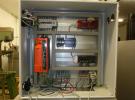Hi,
I have tested the ADXL354 accelerometer Z-axis using Labjack T7-Pro with LJTick-Vref 2.5V, sampling rate 1000 Hz.
For noise check, ADXL354 Z-axis is placed under 0g status. and any acceleration is applied for Z-axis.
In FFT analysis, 60Hz noise is clearly observed as the attachment.
I know that 60Hz noise comes mostly from the power supply.
In this case, I was wondering if the 60Hz noise could be seen as Labjack T7-Pro power supply noise.
I have two Labjack T7-Pro and I see the same 60Hz noise on both devices.
Is it possible to remove 60Hz noise using LJTick-InBuff?
I'd appreciate any advice on how I can get rid of the 60Hz noise.



.png%3Fitok=PHGBxf6M)


.jpg%3Fitok=B1YcuDFK)
.png%3Fitok=Ybt-OlgU)
What resolution index and gain settings are you using? What you are seeing may be close to what we expect for the system noise under stream mode. If that is the case, you would be running up against the limitations of the device and could only achieve better results if you increase resolution index and maximize gain (use ±1V range in your case) which may require lowering your sampling rate. Please see Table A.1.7 for typical maximum stream rates and Table A.1.8 for typical noise:
http://labjack.com/support/datasheets/t-series/appendix-a-1#t7-stream-rates
One specification to note is that if you are bypassing the built in LDO on your accelerometer, and using the Vref as excitation, you would exceed the stated maximum spec (1.98V on V1P8ANA)
As a more general troubleshooting step, it could be useful to do some tests to verify where the noise is coming from. For example, you could remove everything and short the AIN to GND, if that is not noisy disconnect the accelerometer and short the InBuff to GND to check the InBuff, if that looks good connect the Vref to the InBuff to check the Vref.
Thank you for kind response.
As your guide, I tested ADXL354 and Silicon Design 1521L.
For 1521L in single-ended mode, I found the followings
1) No connection : no 60Hz noise peak (Fig 01)
2) only AIN0 is connectd : no 60Hz noise peak (Fig 02)
3) AIN0, GND are connected : 60Hz noise peak (Fig 03)
4) AIN0, Vs are connected : 10Hz noise peak (Fig 04)
5) Vs, GND, AIN0 are connected : no 60Hz noise peak (Fig 05)
For 1521L Using LJTick-InBuff in single-ended mode, I also found the followings
1) No connection : 60Hz noise peak (Fig 06)
2) only AIN0 is connectd : 60Hz noise peak (Fig 07)
3) Vs, GND, AIN0 are connected : no 60Hz noise peak (Fig 08)
For ADXL354 in single-ended mode, I found the followings
1) No connection : no 60Hz noise peak
2) only AIN0 is connectd : no 60Hz noise peak
3) AIN0, GND are connected : 60Hz noise peak (Fig 201)
4) AIN0, Vs are connected : 60Hz noise peak (Fig 202)
5) Vs, GND, AIN0 are connected : 60Hz noise peak (Fig 203, 204)
For 1521L in differential mode, 60Hz noise is observed even in no connection(Fig 101~103).
I don't understand from where 60Hz noise is created.
How can I remove this noise ?
I would appreciate any advice.
I think there are too many variables with what you have currently been looking at, especially considering your last observations, and I am not sure I understand what all conditions you tested under. I would recommend simplifying the setup to try to isolate the issue.
A good place to start is to remove everything from the LabJack but USB (and Ethernet if you are using Ethernet) and jump an AIN to GND to test. I would also recommend testing in our software such as LJStreamM rather than using SIGVIEW and running an FFT. Using LJStreamM will ensure you are looking at the raw data in a program that we are more familiar with. Under this setup do you see similar noise? What levels of noise are you observing?
Without a ground reference from your sensor to the LabJack you will not get meaningful readings. Similarly, if you are not powering the sensors I do not think your sensor readings are meaningful. If you do not see noise with the LabJack by itself (no external connections) I would recommend testing with each sensor fully powered and with GND connected. Test with only one sensor connected to the LabJack at a time, without the InBuff connected, to isolate the test to a single sensor at a time. If you only sample one channel you do not need to worry about settling issues and should not need the InBuff when testing.
Many thanks to your kind explanation.
As your guide, I focused my issue as real measurement.
(I used Labjack T7's 1st channel(Vs, GND, AIN0), and LJStreamM, SigView for FFT)
(I used the accelerometer sensors of ADXL354, single-ended connection)
(ADXL354 is connected to Vs, GND, AIN0 for real measurement)
I observed that the sensor with embeded RC LPF(Low Pass Filter) shows 60Hz peak noise,
and the sensor without embeded RC LPF filter does not shows 60Hz peak noise.
Regardless of RC LPF bandwidth, the same 60Hz peak noise is observed.
Even if 50Hz bandwidth RC LPF is used, the same 60Hz peak noise is observed.
I wonder if this phenomenon is caused by the offset voltage of Labjack's OP Amp connected to AIN0.
I'd appreciate any advice on how I can get rid of the 60Hz noise peak in case of RC LPF.
What peak to peak noise in volts are you seeing from the signal by itself? At a point, you may be running up against the system limitations.
The likely methods to reduce noise are to increase resolution index (and/or stop streaming), increase gain, or add a filter in front. A filter will affect response time, so it is usually worthwhile to increase resolution index and gain first when possible. Resolution 1-8 when using command response should be lower noise than when streaming, however your maximum update rate will typically limited to less than 1000Hz. The 24-bit ADC on the T7-Pro is used when using resolution index 9-12 and usually does well to filter 60Hz noise, but it is much slower than the 16-bit ADC and not supported in stream mode. Our data rates page has some related information:
https://labjack.com/support/datasheets/t-series/appendix-a-1
Do you mean the built in instrumentation amp? There should not be any substantial offset on the InAmp output, but you could test to see if the noise is at the LabJack by shorting an AIN to GND and measuring instead of connecting your signal.
Thanks for the helpful advice.
After trying and error, I found the noise source !!!
This noise came from the AC220V 60Hz.
My PC is powered by AC220V 60Hz and Labjack T7-Pro is connected to the My PC.
Although the AC220V 60Hz power line is grounded, it is presumed that the power line small noise
penetrates through the PC and through the Labjack T7-Pro USB cable to the sensor.
I was wondering if there is a way to properly ground the Labjack T7-Pro in a case like this.
Is there a dedicated power supply unit for the Labjack T7-Pro.
You could use Ethernet for communications instead of USB. With that, you could use any 5V source for power over the USB connector. Something else you could try that might help with noise is to connect a earth ground wire to the SGND terminal on the T7. The 24-bit ADC on the T7-Pro has excellent 60Hz rejection, so that would likely be the best way to filter out noise (using resolution index 9-12).